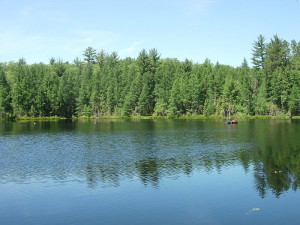Nine-year study tracks how distinct microbial communities evolve in freshwater lakes.
The Science
Researchers sequenced, assembled and analyzed bacterial genomes from a nine-year study tracking the evolution of microbial communities in a Wisconsin freshwater lake.

DNA from water samples collected between 2005 and 2013 from Trout Bog Lake, WI was purified, sequenced, and analyzed for this study. (emoody, Wikimedia Commons)
The Impact
Competing models have been put forward to answer the fundamental question of how microbes evolve, but it remains unclear which evolutionary model is correct. Time series studies of natural populations indicate that a single model does not apply and that, in fact, different microbes in the same environment evolve in different ways.
Summary
By sequencing the DNA collected at many times over nine years (2005-2013) from Wisconsin’s Trout Bog Lake, a team led by University of Wisconsin scientists and including researchers at the U.S. Department of Energy Joint Genome Institute (DOE JGI), a DOE Office of Science User Facility, were able to reassemble the genomes of dozens of freshwater microbes and follow how their genetic makeup changed over time. Surprisingly, they found different evolutionary processes at play within different microbial populations living in the same environment. For example, the team found one bacterial population undergoing a genome-wide selective sweep, a process predicted by the most prominent microbial evolutionary model (i.e., the ecotype model), but never before observed in the wild. During a genome-wide selective sweep, a single member of a population out-competes all others once it acquires an advantageous trait, thus purging genetic diversity within the population. In contrast, they also found other bacterial populations that appear to experience gene-specific sweeps, indicating that high rates of genetic interchange within these populations preserved their diversity. During gene-specific sweep, only the small piece of DNA encoding the advantageous trait is shared with other members of the population through genetic recombination, thereby preventing a takeover by a single dominant strain. The team’s results show for the first time that different populations coexisting in the same environment likely have dramatically different rates of genetic exchange, and that these differences allow populations to evolve according to different non-exclusive theoretical models. This is the first conclusion to come out of a project approved under the DOE JGI’s Community Science Program in 2011 and that was reported ahead online January 8, 2016 in The ISME Journal. The paper has led to two opinion pieces from leaders in the fields of microbial evolution and population genomics.
Contacts
Daniel Drell, Ph.D.
Program Manager
Biological Systems Sciences Division
Office of Biological and Environmental Research
Office of Science
US Department of Energy
[email protected]
Rex Malmstrom
DOE Joint Genome Institute
[email protected]
Funding
- DOE Office of Science
- National Science Foundation
- U.S. Department of Agriculture, National Institute of Food and Agriculture
Publications
- Bendall ML et al. Genome-wide selective sweeps and gene-specific sweeps in natural bacterial populations. ISME J. 2016 Jan 8. doi: 10.1038/ismej.2015.241. [Epub ahead of print]
- Cohan FM. Bacterial Speciation: Genetic Sweeps in Bacterial Species. Curr Biol. 2016 Feb 8;26(3):R112-R115. doi: 10.1016/j.cub.2015.10.022.
- Shapiro BJ. How clonal are bacteria over time? Curr Opin Microbiol. 2016 Apr 5;31:116-123. doi: 10.1016/j.mib.2016.03.013. [Epub ahead of print]